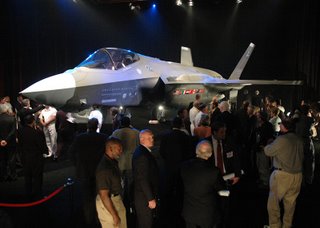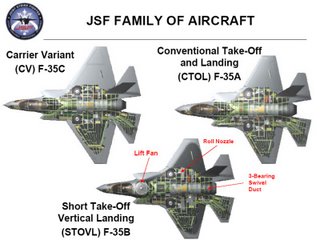Mark "Mustang" Towner wants a check ride?
Air Force's decision to deploy F-35 in Utah is a major boost
By Robert Gehrke and Matthew D. LaPlante The Salt Lake Tribune
Shad Stromberg is eager to get his hands on the controls of the Air Force's newest plane, the F-35A Lightning II. As a pilot at Hill Air Force Base, he is likely to be one of the first. The Air Force announced Wednesday that Hill has been selected to receive one of the first three squadrons of F-35s, a major boost for the future of the base. As many as two dozen of the so-called "Joint Strike Fighter" jets are due to arrive sometime after 2009. The decision would give Hill the Air Force's latest, stealth-equipped jets that cost $112 million apiece. Designed to replace the aging F-16 Falcon, the Lightning is expected to be a front-line weapons system created to hit ground targets without being detected, while still having air-to-air combat capabilities. Former U.S. Rep. Jim Hansen, recently released as a commissioner in the military facility review process known as Base Realignment and Closing, said the decision may significantly insulate Hill from future cuts. He said the Lightning would give Hill an operational mission for decades to come - much the way the Falcon did when it arrived in Utah in the mid-1980s. "At that time, the F-4 was a vanishing breed - it was a great airplane, it had done a wonderful job in Vietnam, but we could see it was going out and the F-16 was coming on," said Hansen, who sat on the House Armed Services Subcommittee as the military debated where to base its Falcons. "Now the F-16s are getting older and everyone wants to be the first base to have the F-35s, and so we're very fortunate to get it. What it means is that Hill is going to be in pretty darn good shape." It's unclear how long Hill has been in the running for the jets. Pentagon officials said the decision materialized over the past few months, while Hill insiders said the base had been selected as early as January. As late as April, however, base officials claimed to have no record of any discussions that had taken place about Utah's suitability to house a Lightning squadron, but then said Wednesday that the process may in fact have been under way earlier than that. Obtaining a Lightning squadron for Hill has been a longtime goal of the Utah Defense Alliance, which has lobbied to keep Hill viable by bringing new missions, technologies and weapons systems to the Davis County base. Vickie McCall, a member of the alliance's executive committee, said the goal took on added importance after Hill was passed over as a location for the Air Force's F/A-22 fighter. Now she thinks Utah got the better end of the deal: A fighter jet, expected to be produced in quantities far greater than the F/A-22 fleet and anticipated to be adaptable to a variety of missions. "It will certainly carry us well into the future," she said. "This is the most modern fighter aircraft. If certainly gives us a workload and mission for Hill Air Force Base for years to come." Retired Gen. Lester Lyles, a former commander of the Air Force Materiel Command at Hill Air Force Base, said he was delighted by the news. The Lightning, he said, "is absolutely state-of-the-art. It is going to be more than just the F-16 of the future. It is going to be the mainstay for years to come." Not everyone agrees with that assessment, though. Initially intended to go into production at about $30 million per plane, the cost of development has ballooned over the past years, to a point where some have suggested that the jet is no longer a viable option for the military. Each plane, manufactured by Lockheed Martin, is now expected to cost about $50 million. But when research and development costs are factored in, the projected price tag already reaches about $112 million, according to a report from the Congressional Research Service. "It's still a paper airplane. We have no clue what the actual performance is. We do know the weight and cost have gone way up," said Winslow Wheeler, director of the Straus Military Reform Project at the Center for Defense Information. "It looks like it's going to be a dog." But the military remains confident enough in the aircraft that leaders expect it to meet a variety of future needs across three service branches. Several allied nations also will receive variations of the jet, which may bring foreign air forces to Hill for training. To get the Lightning, Hill still must pass an environmental study, which can take up to two years, although Air Force officials said it is unlikely that the effect of the F-35 will be much different than the F-16s that frequent the Beehive State skies. That obstacle appears so surmountable, in fact, that Utah politicians eagerly heralded the announcement as the dawning of a new era in the state's long military history. "This is terrific news for Hill and for Utah," said Sen. Orrin Hatch, R-Utah. "It's going to keep Hill strong for decades." Said Rep. Rob Bishop, R-Utah: "Not only is the F-35 vital for the future flying mission of Hill Air Force Base, but it is also the foundation of future jobs at the base." "This designation marks Hill Air Force Base as a base that well represents the future of the Air Force for generations to come," added Gov. Jon Huntsman Jr. Nearly every official contacted by The Salt Lake Tribune said Hill's proximity to the Utah Test and Training Range likely played heavily into the Air Force's decision. Hatch said the Utah delegation's willingness to help the Air Force also may have helped. "The Air Force knows we've been carrying a lot of mail for them," Hatch said, pointing most recently to the Utah delegation's fight to win the Air Force the authority to sign a multiyear procurement contract it wanted for the F/A-22, over the objections of senior senators on the Senate Armed Services Committee. "It made it clear to the Air Force who their friends are." Hatch said he also had pressed Utah's case with Defense Secretary Donald Rumsfeld, Air Force Secretary Michael Wynne and Gen. Mike Moseley, the Air Force's chief of staff. The deal does come with some consequences, though. It could mean that Hill pilots and their new F-35s could be among the first to be thrust into future conflicts with the United States' best-armed enemies. "If it's a relatively low-threat area - Afghanistan, Iraq, that type of stuff - they may be inclined to send A-10s and F-16s. If it's a higher threat area, they're going to hope the F-35 meets its performance promises," Wheeler said.








